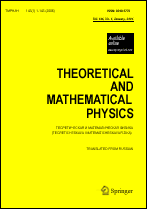|
Refinement of the quantum scattering theory approximation for the Yukawa potential using the Meijer's-function technique
A. N. Starostin, A. G. Sukharev
State Research Center of Russian Federation "Troitsk
Institute for Innovation and Fusion Research,", Troitsk, Moscow, Russia
Abstract:
Our goal is to find and apply simple methods for calculating the scattering cross sections of particles in a screened Coulomb potential in a wider range of wave vector magnitudes than is possible in the Born approximation. Using the technique of Meijer's G-function, we obtain expressions for the scattering amplitude and the quantum scattering cross section in the limit kd≫1, where d is the screening radius and k is the wavenumber. We compare the analytic results with quantum computations of the elastic scattering process by expanding the solution in a power series of partial waves. We investigate the domain of wave vectors where the Born approximation is no longer applicable but the new approximation works. In this domain, the number of angular momenta that must be taken into account in summing the partial cross sections increases abruptly, and a more precise analytic approximation might therefore noticeably reduce the computational effort. We also show that calculations of the classical integrated scattering cross section must take into account that the finite screening length of an interaction potential causes a cross section to shift off the mass shell. Taking this shift into account allows obtaining a good coincidence of numerical and analytic data for the scattering cross section, including beyond the applicability limits of the Born approximation.
Keywords:
quantum scattering theory, partial wave, Meijer's G-function, Born approximation, screened Coulomb potential.
Received: 08.10.2018
Revised: 08.10.2018
Citation:
A. N. Starostin, A. G. Sukharev, “Refinement of the quantum scattering theory approximation for the Yukawa potential using the Meijer's-function technique”, TMF, 199:3 (2019), 460–478; Theoret. and Math. Phys., 199:3 (2019), 878–893
Linking options:
https://www.mathnet.ru/eng/tmf9644https://doi.org/10.4213/tmf9644 https://www.mathnet.ru/eng/tmf/v199/i3/p460
|


| Statistics & downloads: |
| Abstract page: | 406 | | Full-text PDF : | 151 | | References: | 56 | | First page: | 15 |
|




 Contact us:
Contact us: Terms of Use
Terms of Use
 Registration to the website
Registration to the website Logotypes
Logotypes









 Citation in format
Citation in format 